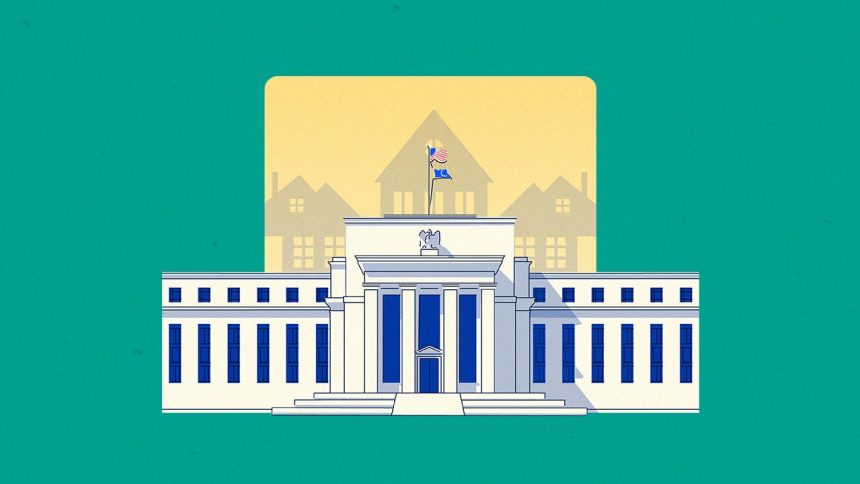The Federal Reserve’s interest rate decisions influence the rates you pay for variable-rate home equity lines of credit (HELOCs) and new home equity loans.
Fed officials announced on May 1 that they will leave interest rates unchanged at a 23-year high. Policymakers also signaled that they have no immediate plans to lower interest rates.
“Over the past year, as labor market tightness has eased and inflation has declined, the risks to achieving our employment and inflation goals have moved toward better balance,” says Jerome Powell, chairman of the Federal Reserve. “The economic outlook is uncertain, however and we remain highly attentive to inflation risks.”
This is the sixth straight meeting the Federal Open Market Committee (FOMC) kept its key benchmark federal funds rate in the 5.25 to 5.5 percent target range.
Previously, the central bank had indicated plans to slash rates three times in 2024. Now, however, “the Fed is not in a hurry to start cutting interest rates as the progress toward 2 percent inflation has encountered some turbulence,” says Greg McBride, CFA, Bankrate’s chief financial analyst.
So what does that mean for home equity products? Let’s break down how the Fed’s monetary policy affects HELOCs and new home equity loans.
How does a Fed rate affect HELOCs?
When the Fed changes the federal funds rate, the interest rate banks charge each other for overnight loans to meet reserve requirements, it affects other benchmarks — such as the prime rate, the interest lenders charge their largest, most favored clients. The prime usually runs 3 percentage points higher than the fed funds rate. When the fed fund rate moves, the prime rate moves up or down in tandem. Many lenders directly tie the rates on HELOCs and home equity loans to the prime rate — often adding extra percentage points onto them — for the ultimate rate you, the borrower, pay.
Maintaining the status quo at this last Fed meeting suggests HELOCs should remain roughly the same, short-term. But they’ve had a bumpy ride: In November 2023, the average HELOC interest rate eclipsed 10 percent — the highest HELOC rate in over 20 years, according to Bankrate’s national survey of lenders. They dipped back down into the single digits with the new year, though. And, along with home equity loans, they’re forecast to retreat further in 2024.
What home equity borrowers should know about the Fed
Because HELOCs usually have variable interest rates, the cost of borrowing can rise or fall with the federal funds rate. If the fed funds rate goes up, your HELOC gets more expensive.
Home equity loans, on the other hand, come with fixed rates, so they aren’t as deeply impacted by fed funds rate movement. Once you close the equity loan, your rate won’t change. But of course the rate you get on a new loan reflects the fed funds rate activity and its impact on the prime rate.
If you want stability in your budget, know that with a HELOC, there’s no real way to predict whether rates will rise, fall or stay the same. Not only does your interest rate affect monthly costs; it can also greatly impact how much you pay for the line of credit overall.
Before you open a HELOC, understand the maximum interest rate, when the draw period ends and whether you’re responsible for interest payments only (or not) during this period.
If you already have a HELOC but don’t have a balance (in other words, haven’t drawn from it), rising rates won’t affect your wallet all that much. If you do owe, you’ll have a larger monthly payment to cover, usually within the next two billing cycles. This applies whether you’re in the draw or repayment phase.
If rates do rise, you might want to explore whether you can lock in a fixed rate on a portion of your HELOC balance. This isn’t an option with every lender, and it might have some limitations if it is, however.
Home equity loan or HELOC: Which is better?
There’s no single answer. Depending on the Fed’s policy, where interest rates are heading and the nature of your financial need, one may be more ideal than the other.
HELOCs benefit most from rate decreases. With the Fed looking to lower rates later in 2024, a HELOC may be more beneficial than a home equity loan because the rate could go down. Also, with a HELOC, you can draw funds as you need them, and you only have to pay interest on the funds you actually take out. So, if you don’t need the full sum on your line of credit upfront, you can take what you need now and wait until rates drop to withdraw more.
On the other hand, home equity loans on average have lower interest rates than HELOCs. As of May 1, interest rates on HELOCs average 9.88 percent, while 15-year home equity loans average 8.80 percent, according to Bankrate’s national survey of lenders.
If the Fed doesn’t move its fed funds rate significantly this year, fixed-rate home equity loans could maintain a lower rate than HELOCs. If you need a set large amount, a home equity loan will get you the funds with a predictable monthly payment. Plus, if rates fall by a large amount, you could always consider refinancing your HE loan, though you will likely need to pay closing costs.
“If you’re undertaking a home improvement project where costs will be incurred in stages, that is best suited to a home equity line of credit,” says McBride. “If you’re doing a debt consolidation where all the funds are disbursed at once, a fixed rate home equity loan may be the better choice.”
Is now a good time to get a home equity loan or HELOC?
With the Fed’s current stance on taming inflation, rates could remain elevated until inflation falls within the Fed’s 2 percent benchmark.
“The decision about whether to take a home equity line of credit or a home equity loan depends more on the borrower’s need for the funds and purpose for borrowing than it does on the interest rate, especially now that interest rates have peaked and are poised to start pulling back,” says McBride. So, if you have a pressing need for funds, now may be the time to take action. If you wait, interest rates could fall, but when and by how much remains to be seen.
Bottom line on the Fed’s effect on HELOCs and HE Loans
The Federal Reserve’s interest rate decisions affect borrowing costs for many types of financial products, including home equity loans and lines of credit (HELOCs). When the Fed lowers its key rate, it causes the rates that lenders ultimately set for HELOCs and new home equity loans also to drop, and vice versa.
At its meeting on May 1, the Fed decided to maintain its key rate for the sixth meeting in a row. But there could be rate cuts on the horizon if inflation lessens. If you plan on taking out a home equity loan — or already have a HELOC — keep an eye on how the rates attached to them change following a Fed announcement.
Read the full article here
















